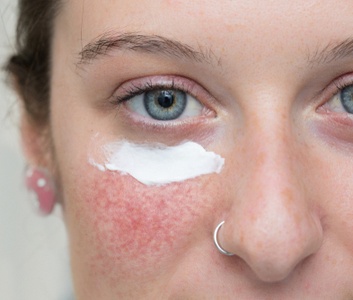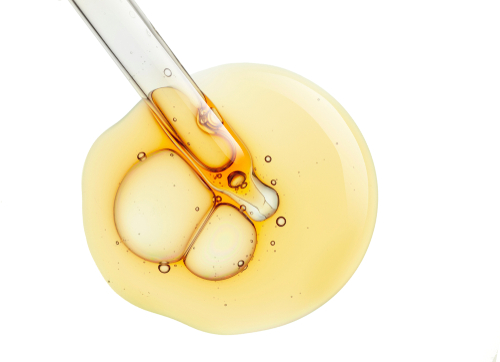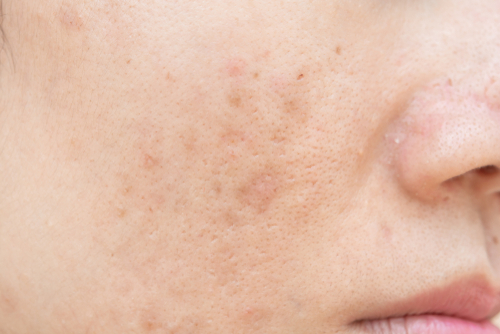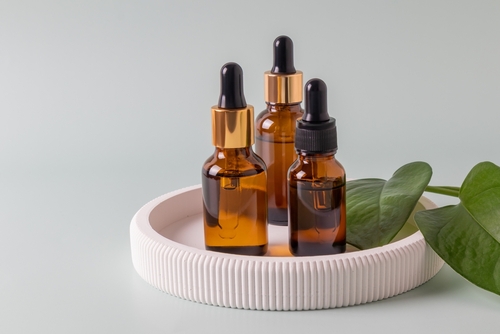Blog
Welcome to FaceForward
Get the scoop on all things beauty, wellness, and skincare.

Even if you don’t know much about skincare, you’ve probably heard of azelaic acid and retinol (or the broader class of medications, retinoids).
These are two popular skincare ingredients with a long list of powerful acne-fighting and skin-healing properties.
While the benefits of azelaic acid and retinol are similar, dermatologists recognize just how effective they are when used together.
We’ve compiled this article to outline everything you need to know about these two powerhouse ingredients and why they may be the perfect skincare match.
Summary
|
Azelaic acid is an anti-inflammatory skincare ingredient that can be found in grains like wheat and barley.
As part of the dicarboxylic acid family, azelaic acid has antibacterial properties that help keep skin clear of bacteria and pathogens. It’s also more gentle than beta hydroxy acids (BHAs) like salicylic acid.
This is why topical azelaic acid is often prescribed to help treat common skin conditions like acne, rosacea, and hyperpigmentation.
Azelaic acid is also a tyrosinase inhibitor. It inhibits the production of enzymes like keratin, a protein responsible for maintaining the structure of our skin, hair, and nails. While keratin is necessary for the skin to stay firm and protected, it can also cause oil to build up and breakouts to develop.
This happens when the skin becomes damaged and keratin molecules bind together as a protective mechanism. These cells can eventually clump together and clog pores.
By slowing keratin production, azelaic acid can work to clear clogged pores and prevent acne breakouts.

Azelaic acid is a popular skincare ingredient because it’s relatively gentle and rarely causes severe adverse reactions.
Its ability to regulate the amount of oil on the skin helps to keep pores clear and prevent blemishes from forming.
Azelaic acid also has soothing properties, which help reduce redness and inflammation caused by rosacea-prone skin.
Not only does azelaic acid exfoliate and remove dead skin cells, but it can also improve the texture of the complexion over time.
As we mentioned earlier, azelaic acid can inhibit tyrosinase enzymes like melanin. This is a naturally-occurring substance that affects the pigment of the skin and absorbs UV radiation to protect it from sun damage.
Although melanin is essential for the overall health and color of the skin, overproduction can cause hyperpigmentation. Azelaic acid can help regulate this process and prevent dark spots from forming.
Dermatologists often recommend using products containing an azelaic acid concentration of between 10% and 15% for best results. These concentrations are strong enough to deliver the benefits of azelaic acid, but are unlikely to cause skin irritation.
Milder concentrations may also be effective, but it may take longer to see visible results.
Azelaic acid is one of the most gentle skincare ingredients on the market. In fact, it’s such a well-tolerated ingredient that severe adverse reactions are very rare.
If a person experiences side effects, they are usually mild and occur due to the skin’s natural reaction to using a new product. Common side-effects of using azelaic acid for the first time include:
These side effects usually go away on their own as the skin adjusts to the azelaic acid.
Dermatologists usually recommend gradually incorporating azelaic acid into your skincare routine over a few days to weeks. This gives your skin time to get used to the product and minimizes the risk of adverse reactions.
Although severe reactions are unlikely, they can include the following symptoms:
If you experience any of these side effects, contact your health care professional or dermatologist as this may indicate that you’re allergic to azelaic acid.
Retinol is part of the retinoid family that are derivatives of vitamin A—this is a micronutrient known for its anti-aging and acne-fighting properties.
Not only is vitamin A essential for optimal skin health, it also helps stimulate collagen production and skin cell turnover.
Vitamin A is powerful for increasing the skin cell turnover process. This is when the skin produces new cells that replace dead ones on the surface. This process helps push dirt, bacteria, and other impurities from the skin's surface to help keep it clear and less acne prone, too.
Vitamin A also prevents free radicals from breaking down collagen molecules and causing the skin to sag. Collagen is an important protein that helps the complexion maintain structure and elasticity.
Other than retinol, there are many forms of retinoids that can help the skin fight breakouts and common signs of aging. These include:
Read more about retinoids in our ultimate guide to picking the best retinoids.
Retinol is available in a variety of strengths. Depending on your skin’s needs or condition, you might use a lower or higher concentration of retinol.
Most people will only experience sensitive skin or irritation if they use a too-potent retinol or retinoid formulation for their skin.
Skin irritation can also occur if you use the retinoid too much or if the product is applied during the day and exposed to the sun without proper protection.
Retinoids are potent ingredients, and it’s common for more severe irritation or “skin purging” to occur when first beginning use. A retinoid purge happens while the skin adjusts to a new product. Retinoids also cause the skin’s cell turnover process to occur more frequently than usual.
When this happens, impurities are elevated to the surface of the skin more quickly. This is one reason for side effects of a retinoid purge. These often include:
Although these side effects are common, many people might think that they should stop using retinol immediately when they become visible. However, a retinoid purge is a completely normal reaction while the skin adjusts. It can last anywhere from a few days to several weeks.
The irritation usually clears on its own once the skin has adjusted to the new products and their concentration.
To minimize severe adverse reactions, most dermatologists recommend gradually incorporating retinoids into a skincare routine.
Retinoids can be applied once or twice a week at first, increasing frequency as the skin gets used to them. Using soothing skincare ingredients like niacinamide can also help manage the side effects of a retinoid purge.
Studies show that there are many benefits to using azelaic acid and retinol together.
Both ingredients treat similar conditions in different ways, which is why they can complement each other well when combined. In this way, azelaic acid and retinol can create a targeted treatment to combat common skin conditions.
Let’s take a look at a few examples of how these two ingredients can work together.
When retinol or a prescription retinoid like tretinoin is used as an acne treatment, for example, it stimulates the production of new skin cells that help remove oil and dirt from the surface.
These new cells will also replace the damaged ones, revealing a smoother complexion. However, retinol can cause mild inflammation and irritation initially, which is where azelaic acid comes in.
Azelaic acid’s anti-inflammatory properties can help soothe irritation and prevent damage that may occur from redness or dry skin.
Since retinol stimulates the production of new skin cells, these can replace those affected by hyperpigmentation.
If azelaic acid is used in the same skincare routine, it’s also known to help improve the appearance of hyperpigmentation.
By regulating the production of melanin, azelaic acid slows the formation of dark spots and can help lighten them over time.
 How Often Should I Use Retinol and Azelaic Acid?
How Often Should I Use Retinol and Azelaic Acid?“When combining two powerful skincare ingredients, a gradual approach is always best,” says Dr. Lilliana Ramirez, a board-certified dermatologist and the Director of Skincare Success at Nava MD.
Below we take a closer look at some of Dr. Ramirez’s recommendations for combining these two ingredients and minimizing the risk of severe adverse reactions occurring.
If you want to combine azelaic acid and retinol, it’s recommended to start out with one product at a time for a couple of weeks before incorporating the next one.
Start by applying the first ingredient once a week and increase the frequency of use over time. For example, use it twice in the second week and three times in the third week.
Then start incorporating the second ingredient in the same way, combining it once a week and building up a tolerance from there.
It will also help you keep track of any irritation that occurs, giving you time to adjust the concentration or frequency of application.
If you use both products without allowing the skin to build a tolerance first, it can be difficult to distinguish which ingredients irritate your skin.
Once you’ve successfully incorporated and combined both ingredients into your skincare routine, it’s recommended that you use them once a day at night.
Retinoids become unstable when exposed to sunlight and can cause the skin to be more vulnerable to free radical damage.
It’s also advised that you wait at least 30 minutes between the application of an ingredient before moving on to the next one.
This allows the skin to fully absorb the first ingredient and gives it time to adjust to the concentration levels.
You can also opt for a skincare product that contains both azelaic acid and retinol in one formula.

One of the most effective ways to ensure a clear and healthy complexion is by using skincare products with targeted, active ingredients like these.
At Nava MD, we keep skin health top of mind when formulating our range of over-the-counter (OTC) and prescription treatments. That’s why our products contain acne-fighting ingredients like azelaic acid, tretinoin, niacinamide, and clindamycin to help you achieve your best skin.
Even better––have a dermatologist direct your plan.
Our in-house clinicians can create a personalized treatment plan based on your specific needs.
It starts with our free online consultation, then one of our board-certified dermatologists determines the right formulas and concentrations for you.
If approved, your personally selected and prescribed formulas will be delivered straight to your doorstep. You’ll also have access to our clinicians any time to answer any questions or concerns you may have.
Start your free consultation at Nava MD today.
This article is intended for informational purposes only and should not be considered medical advice.
Consult a healthcare professional or call a doctor in the case of a medical emergency